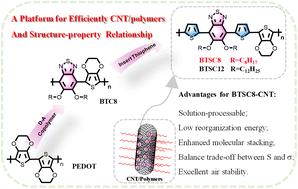通过分子包装工程,显著提高了溶液可加工有机聚合物和碳纳米管复合材料的热电性能
IF 9.5
2区 材料科学
Q1 CHEMISTRY, PHYSICAL
引用次数: 0
摘要
可溶液加工有机聚合物与具有优异导电性的碳纳米管(CNTs)相结合已被证明是提高热电性能的有效策略。然而,对构建优质聚合物的重视程度严重不足,聚合物结构与聚合物/碳纳米管复合材料热电性能之间的相关性不明确,这在很大程度上阻碍了热电参数的进一步提高。本研究以相同的主构元、不同的烷基侧链、不同的分子刚度/平面度构建了三种单步合成有机聚合物BTC8、BTSC8和BTSC12,揭示了它们显著的构效关系。在BTSC12和BTC8基共混膜中,烷基链的凝聚和同时增强的刚性/平面度可以降低电子重组能,促进有效的分子填充,从而为BTSC8/SWCNT基共混膜提供了良好的电荷传输通道。与BTSC12和BTC8基共混膜的188.8和159.7 μW m−1 K−2相比,BTSC8基共混膜的功率因数为241.4 μW m−1 K−2,空气稳定性良好。我们的工作表明,通过分子包装工程,如提高分子刚度/平面度,降低重组能和加强分子包装,平衡塞贝克系数和电导率之间的平衡,可以显著提高共轭聚合物/碳纳米管的热电性能。本文章由计算机程序翻译,如有差异,请以英文原文为准。

Significantly enhanced thermoelectric performance of a solution-processable organic polymer and carbon nanotube composite via molecular packing engineering
Combining solution-processable organic polymers and carbon nanotubes (CNTs) with excellent electrical conductivity has been demonstrated to be an effective strategy to elevate thermoelectric performance. Nevertheless, the seriously inadequate attention given to constructing superior polymers and the ambiguous correlation between polymeric architectures and the thermoelectric properties of polymer/CNT composites largely impede the further improvement of thermoelectric parameters. Herein, three one-step synthetic organic polymers named BTC8, BTSC8 and BTSC12 are constructed with the same main building units but different alkyl side chains and molecular rigidity/planarity to reveal the significant structure–property relationship. The condensed alkyl chains and simultaneously enhanced rigidity/planarity could reduce electron reorganization energy, facilitate effective molecular packing and thus provide excellent charge transport channels in BTSC8/SWCNT based blend films, affording a superior power factor of 241.4 μW m−1 K−2 with satisfactory air stability compared to 188.8 and 159.7 μW m−1 K−2 for BTSC12 and BTC8 based blend films, respectively. Our work demonstrated that conjugated polymer/CNT based thermoelectric performance could be dramatically increased by balancing the trade-off between the Seebeck coefficient and electrical conductivity via molecular packing engineering such as improving molecular rigidity/planarity, reducing reorganization energy and strengthening molecular packing.
求助全文
通过发布文献求助,成功后即可免费获取论文全文。
去求助
来源期刊

Journal of Materials Chemistry A
CHEMISTRY, PHYSICAL-ENERGY & FUELS
CiteScore
19.50
自引率
5.00%
发文量
1892
审稿时长
1.5 months
期刊介绍:
The Journal of Materials Chemistry A, B & C covers a wide range of high-quality studies in the field of materials chemistry, with each section focusing on specific applications of the materials studied. Journal of Materials Chemistry A emphasizes applications in energy and sustainability, including topics such as artificial photosynthesis, batteries, and fuel cells. Journal of Materials Chemistry B focuses on applications in biology and medicine, while Journal of Materials Chemistry C covers applications in optical, magnetic, and electronic devices. Example topic areas within the scope of Journal of Materials Chemistry A include catalysis, green/sustainable materials, sensors, and water treatment, among others.
 求助内容:
求助内容: 应助结果提醒方式:
应助结果提醒方式:


